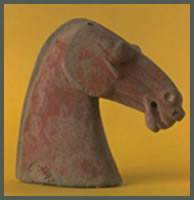| | HEAD OF A HORSE |
| |
| | Chinese, Six Dynasties Period, 265-589 AD |
 |
| | From a grave; earthenware |
| | Gift of Alice Lusk Webster, 1935 (A44.8) |
| |
| | Chinese burial customs relect concern with
human mortality and belief in the existence of an afterlife. Graves were furnished with the
necessities and luxuries to provide a congenial environment for the spirit. |
| |
| | Early burial practices, continuing into the
Shang and Zhou Dynasties (1523-221 BC), included human and animal sacrifice on a massive scale.
Tombs of the Shang Dynasty, for example, have been found containing the bodies of several hundred
slaves, who had been buried alive. |
| |
| | During the Shang and Zhou Dynasties,
funerary sculpture gradually replaced the human and animal sacrifices that were completely abandoned
by the fourth century BC. Most funerary sculptures are small, but excavations have also unearthed
spectacular life-size terracotta figures, in one case an entire army marching in formation. |
| |
| |  |
| |
|